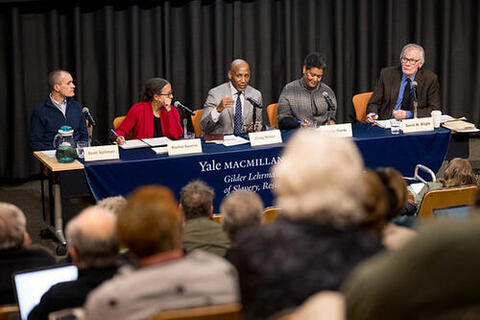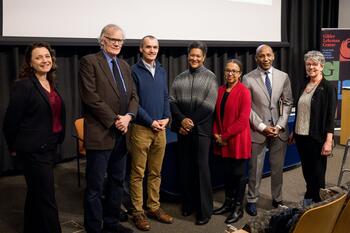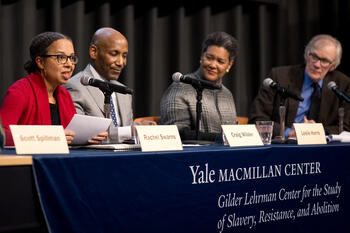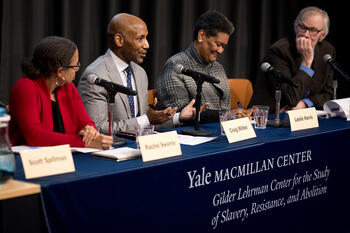Reckoning with Slavery in US Intellectual History and the University

By Evan Turiano, Walter O. Evans Fellow for the Study of Slavery and Race, Gilder Lehrman Center and Beinecke Library
On December 13, 2023, the Gilder Lehrman Center for the Study of Slavery, Resistance, and Abolition (GLC) at the Yale MacMillan Center hosted a panel of eminent historians to examine slavery’s legacies in American universities and in the intellectual traditions those universities have produced. The GLC organized the event in anticipation of the February 2024 release of Yale and Slavery: A History (Yale University Press, February 2024), a new narrative history committed to uncovering Yale’s connections with human bondage.
The panel was moderated by David W. Blight, Sterling Professor of History, Director of the Gilder Lehrman Center, and lead author of Yale and Slavery. Blight’s opening remarks struck a pragmatic but hopeful tone, noting that the evening’s panelists emblemized a “fruitful crossroads in how institutions of higher learning reconstruct their own institutional memory and identity.” Blight expressed hope that efforts to recognize and repair institutional tie to slavery could help universities keep their eye on their “profoundly important” guiding ideals.
Panelists included Scott Spillman, Postdoctoral Research Associate at the Gilder Lehrman Center. His forthcoming book, due out with Basic Books, is titled Making Sense of Slavery: An American History. Spillman spoke first, providing a 250-year intellectual context for the evening’s guiding questions. “Reckoning with slavery,” Spillman told the audience, “is nothing new in American intellectual life; it’s been there since the beginning, and has shaped the contours of American intellectual life.” The study of slavery stretches back to the 1750s and factored prominently into debates over slavery’s future. The end of slavery, according to Spillman, “fundamentally changed the way that slavery was studied. [People began to] have questions about it, what it was, what role it played in American history and in the Civil War.” As the generations that witnessed slavery dwindled, “people began to answer these questions through research, in a new institution that was the modern research university.”
 This first generation, committed to a notion of “dispassionate” scholarship, ended up “tak[ing] slavery out of American political history, [and taking] the morality question out of the study of slavery.” A key player in this shift was Ulrich Bonnell Phillips, the first professional scholar of American slavery, who ended his prolific career at Yale. According to Spillman, Phillips’s interpretation of slavery as a “benign or indeed beneficent institution” spent decades as the “dominant story, but was never without challenges. Those challenges would ultimately overcome and overturn the old interpretation.” In the wake of the Civil Rights Movement, scholars began to ask new questions about if, and how, they should bring their findings about slavery and its central place in American life to public audiences. It was these new questions, Spillman concluded, that led universities to begin studying their relationship with slavery.
This first generation, committed to a notion of “dispassionate” scholarship, ended up “tak[ing] slavery out of American political history, [and taking] the morality question out of the study of slavery.” A key player in this shift was Ulrich Bonnell Phillips, the first professional scholar of American slavery, who ended his prolific career at Yale. According to Spillman, Phillips’s interpretation of slavery as a “benign or indeed beneficent institution” spent decades as the “dominant story, but was never without challenges. Those challenges would ultimately overcome and overturn the old interpretation.” In the wake of the Civil Rights Movement, scholars began to ask new questions about if, and how, they should bring their findings about slavery and its central place in American life to public audiences. It was these new questions, Spillman concluded, that led universities to begin studying their relationship with slavery.
Leslie Harris spoke next. Visiting from Northwestern University, she is, along with James T. Campbell and Alfred L. Brophy, coeditor of Slavery and the University: Histories and Legacies (2019), among many other publications. Harris provided an inside perspective on the study of slavery and the university based on her experience leading Emory University’s Transforming Community Project from 2004 to 2011. She co-founded the project to address a perceived disconnect between the school’s on-paper diversification and the quality of cross-cultural dialogues. “Emory had perfect ‘numbers,’” Harris explained, “but nobody could talk to each other about the issues at the center of the university.” The project’s goal, she explained, was to go from understanding the community as numbers and percentages toward understanding community “as a verb.” This, Harris asserted, required making space for “uncomfortable” learning.
The results were two-fold. First, the project’s efforts “developed leadership, a new group of people who were prepared to help people dialogue rather than fight.” Secondly, the project opened doors for future dialogues—“it gave us a language for addressing [diversity] issues.” Harris concluded with two calls for action. First, she called on conversations about the slavery and the university to “include non-R1 universities, which bridge inequities in our K-12 education system and society more broadly.” Harris insisted that inquiries into the relationship between slavery and the university needed to find the next step, to “push this work to a new place, not just publishing a book, but living in a new reality.”
 After Harris’s remarks, Rachel Swarns spoke about her research on Georgetown University’s intimate relationship to slavery and the slave trade, and about what efforts Georgetown has undertaken in light of those truths. Swarns is a Professor of Journalism at New York University and a longtime reporter, correspondent, and contributor to the New York Times. Her recent book, The 272: The Families Who Were Enslaved and Sold to Build the American Catholic Church (2023) reconstructs the lives of enslaved people sold by Jesuits in 1838, the proceeds from which funded Georgetown University and shaped the early American Catholic Church. Swarns began her remarks by noting that, even as some scholars and members of the Georgetown community knew about the 272 people who were sold and families that were torn apart, her archival research revealed and then disproved layers of comforting institutional narrative. The archive, she said, “belied the story of the Catholic priest as a kindly master.” Archival documents clearly demonstrated that Catholic clergy were regularly engaged in the sale of enslaved people before the famous 1838 mass sale. Her research also revealed that Georgetown’s ties to enslavement stretched beyond 1838; income from the sale continued to pour into Georgetown until the 1860s, and the university relied on slavery in various ways until emancipation. Most damningly, she discovered that Georgetown’s prior institutional knowledge contained “no significant effort to tell the story of these enslaved people themselves, without whom the university probably would not exist as we know it today.”
After Harris’s remarks, Rachel Swarns spoke about her research on Georgetown University’s intimate relationship to slavery and the slave trade, and about what efforts Georgetown has undertaken in light of those truths. Swarns is a Professor of Journalism at New York University and a longtime reporter, correspondent, and contributor to the New York Times. Her recent book, The 272: The Families Who Were Enslaved and Sold to Build the American Catholic Church (2023) reconstructs the lives of enslaved people sold by Jesuits in 1838, the proceeds from which funded Georgetown University and shaped the early American Catholic Church. Swarns began her remarks by noting that, even as some scholars and members of the Georgetown community knew about the 272 people who were sold and families that were torn apart, her archival research revealed and then disproved layers of comforting institutional narrative. The archive, she said, “belied the story of the Catholic priest as a kindly master.” Archival documents clearly demonstrated that Catholic clergy were regularly engaged in the sale of enslaved people before the famous 1838 mass sale. Her research also revealed that Georgetown’s ties to enslavement stretched beyond 1838; income from the sale continued to pour into Georgetown until the 1860s, and the university relied on slavery in various ways until emancipation. Most damningly, she discovered that Georgetown’s prior institutional knowledge contained “no significant effort to tell the story of these enslaved people themselves, without whom the university probably would not exist as we know it today.”
In the last decade, though, a great deal has changed. Georgetown’s attempts at repair stretch back before Swarns’s book and before student protests. Various steps the university has taken include a formal apology, the changing of building names to commemorate people who were enslaved and sold, preferential “legacy” admissions status for the descendants of the 272 people sold, the founding of a digital archival about Jesuit slaveholding, an alumni fund committed to initiatives that benefit descendants, and a mandatory seminar on Georgetown and slavery for all undergraduates. Swarns admitted that the path has not always been smooth, and that “reception has been mixed” among both descendants and the Georgetown community, but that Georgetown’s approach, rooted in Jesuit ideals, has led them into an approach that can model real change for other universities.
Craig Steven Wilder spoke last. Wilder is the Barton L. Weller Professor of History at Massachusetts Institute of Technology. His landmark book, Ebony & Ivy: Race, Slavery, and the Troubled History of America’s Universities (2013), played a large role in kicking off the recent wave of reckonings with slavery’s legacy on college campuses across the United States. He began his remarks by reflecting on the evolution of studies related to slavery and the university. “When I started this research,” he began, “I looked for every off ramp.” The two decades since, he said, have “been a story of persistence.” Wilder then discussed surprising findings from his current research about the Massachusetts Institute of Technology’s relationship to American slavery. Given that the Institute was founded in 1861 in the relative antislavery hotbed of Boston, slavery held no real place in MIT’s institutional memory. “We had wrapped ourselves in [the abolitionist] tradition,” Wilder said, “and in the notion that we had no connection to slavery. That was wrong.” This is, in part, a structural story: slavery fueled an “engineering revolution” in the United States in the four decades preceding the Civil War, and MIT’s founding was “the last bright spot of that revolution.”
 The Institute’s particular ties to slavery center on its founder William Barton Rogers, who bought enslaved people when teaching in Virginia during the antebellum period. The most notable finding to come out of Wilder’s examination of Rogers—who is widely credited with helping establish the field of geology in the United States—was the prominent role Levi, his enslaved research assistant, played in his scholarship and in the course of early American geology. “What happens,” Wilder asked, “when we think of enslaved people in the production of knowledge? What happens when we put them at the center of the story?”
The Institute’s particular ties to slavery center on its founder William Barton Rogers, who bought enslaved people when teaching in Virginia during the antebellum period. The most notable finding to come out of Wilder’s examination of Rogers—who is widely credited with helping establish the field of geology in the United States—was the prominent role Levi, his enslaved research assistant, played in his scholarship and in the course of early American geology. “What happens,” Wilder asked, “when we think of enslaved people in the production of knowledge? What happens when we put them at the center of the story?”
Audience questions offered the panelists a chance to share more details about their research and campus experiences. Swarns discussed how her research, bleak as it often was, ultimately strengthened her personal relationship with the Catholic Church. “Many of these families [that were] enslaved and sold by the Jesuits remained Catholic after the Civil War. For them, the Church did not belong to these sinful white men. It belonged to them too…Growing up, I did not see myself in the Church. I see myself now.” Spillman drew connections between his work and Wilder’s, as each sought to reach across time for real intellectual engagement. “I try to take these people—that are easy to demonize—seriously as scholars, the same way Craig talked about taking Levi seriously as a scholar. I try to find their scholarly ideals, and then see where they [fell] short of them.” Harris emphasized about the importance on not shying away from uncomfortable conversations, nor abandoning dialogues when decorum collapses. “Sometimes it blows up. How do you repair? We can’t keep voting everyone off the island.”
The panel concluded by addressing the urgent need for next steps, and how to turn their inquiries into meaningful reparative efforts. “Twenty years in,” Harris lamented, “every institution feels the need to have a commission, but doesn’t feel the need to repair beyond renaming buildings.” One road for real change, she suggested, might be for elite institutes to share resources and developmental skills with HBCUs and Hispanic-serving institutions that have greater potential to promote equity in the United States. Blight suggested that universities might draw from the long, international tradition of reparations. “If we only focus on our own navels,” he warned, “we are making a mistake.” Harris put the same sentiment into a call to action: “How are you going to walk differently now that you know?”
View a recording of the program:
